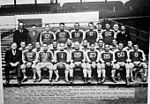Morris–Jumel Mansion

The Morris–Jumel Mansion or Morris House (also known as the Roger and Mary Philipse Morris House, "Mount Morris" and Morris–Jumel Mansion Museum) is an 18th-century Federal style museum home in upper Manhattan, New York City. It was built in 1765 by Roger Morris, a British military officer, and served as a headquarters for both sides in the American Revolution. Located at 65 Jumel Terrace, in Roger Morris Park in the Washington Heights neighborhood of Manhattan, New York City, it is the oldest house in the borough. The home and grounds were purchased as a museum home in 1903 and declared a National Historic Landmark in 1961. The exterior was designated a New York City Landmark in 1967, with the interior following in 1975. The area around the Morris-Jumel Mansion, the Jumel Terrace Historic District, was also designated as a New York City historic district in 1970.
Excerpt from the Wikipedia article Morris–Jumel Mansion (License: CC BY-SA 3.0, Authors, Images).Morris–Jumel Mansion
Jumel Terrace, New York Manhattan
Geographical coordinates (GPS) Address Website External links Nearby Places Show on map
Geographical coordinates (GPS)
| Latitude | Longitude |
|---|---|
| N 40.834444444444 ° | E -73.938611111111 ° |
Address
Morris-Jumel Mansion
Jumel Terrace
10032 New York, Manhattan
New York, United States
Open on Google Maps










